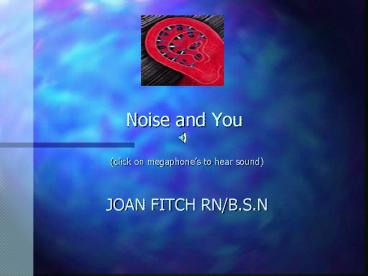click on megaphones to hear sound PowerPoint PPT Presentation
1 / 22
Title: click on megaphones to hear sound
1
Noise and You
- (click on megaphones to hear sound)
- JOAN FITCH RN/B.S.N
2
Why worry about noise?
- Of all the pollution concerns
- Air,water,land, and noise noise pollution is the
one that has the potential for the most damage to
humans and wildlife. - It is a hidden health hazard that impacts our
physical, psychological and intellectual well
being. - Our ears never shut down, even while we are
sleeping, so the input is constant.
3
Noise Pollution
- Noise pollution has a broad effect.
- It can excite us
- Warn us of danger
- Soothe us
- Inspire us
- Keep us in touch with our surroundings.
- And, harm our well being.
4
Noise is Everywhere
5
Hearing
- Our ability to hear is one of our great senses
that connects us with the world around us. - Without it, the world becomes a lonely,
frightening place.
6
Our Magical Ears
7
Those Handles on Our Heads
- Our ears arent there for decoration!
- They are amazing neurotransmitters that gather
and process sound, sending the input off to our
brain where fascinating things happen.
8
The Ear and Our Brain
- Our brain processes the sound waves received via
our ears and makes determinations that effect
speech, balance, and hearing. - Excess stimulation from sound can overload our
nervous system resulting in many negative health
symptoms.
9
What does our ear drum do?
- Sound waves are collected by our ear canal and
passed to the ear drum, which vibrates. The
sound waves are then picked up by fluid in the
inner ear and passed to the inner ear structures
where the acoustic nerve connects to the brain.
10
The Mighty Decibel
- Decibels measure the intensity of sound.
- Hearing loss can occur from a single exposure to
a loud noise or from repeated exposures. - The Environmental Protection Agency has set a
standard of 70 db in a 24 hour period as safe.
11
The Numbers
- Stereo - 90 db
- bagpipes - 90-110 db
- power saw - 100 db
- fire cracker - 115-120 db
- rock concert - 120 db
- gunshot/train/jet -
- 150 db
- Rustling leaves- 10db
- whisper - 30 db
- normal speech - 60 db
- television - 70 db
- traffic - 75-80 db
- blow dryer - 85 db
- noisy hall - 85 db
- classroom - 85 db
12
Physical Effects
- Examples hearing loss, digestive disorders,
birth defects, arthritis, cancer, heart disease,
fatigue, headaches, asthma, hypertension,
insomnia, sexual dysfunction, altered immune
system.
13
Psychological Effects
- Examples depression, anger, aggression, anxiety,
increased violence, alcohol and drug use,
fatigue, increase in suicide, decreased social
skills, personality disorders
14
Communicative Effects
- Examples decreased learning capacity, memory
loss, poor language skills, decreased speech
development, decreased academic performance,
decreased cognitive ability
15
How much is too much?
- Damage to health begins at 75 db.
- Hearing damage begins at 90 db and can be
permanent with one exposure of 120 db or more. - The average decibel levels at Montpelier High
School are 70-86 where damage to physical,
psychological and communicative health begins.
16
Music To Your Ears?
- As a bagpiper I am acutely aware of the impact of
noise on my well being. The average bagpipe
generates 90-110 db. - It is important in any of our health arenas that
we make deliberate choices about how to protect
ourselves.
17
Shhhhhh
- How can we stop the constant bombardment to our
ears and protect our over all health?
18
Stopping the Noise
- It cannot be done!
- Even during sleep our ears are absorbing sound
waves that are then processed by our brain. - What we can do is seek practical ways to diminish
the noise OR protect our ears from receiving too
much damaging input, i.e. decibels.
19
Know Thyself
- Respecting sounds and how they can impact your
health involves knowing yourself. We all have
different thresholds of what we can handle. - What kinds of sounds stimulate you, soothe you,
irritate you? - Do you find you have ringing in your ears after
certain sound exposures? - Is there a family history of hearing loss?
20
So, Now What?
- How do you balance what you enjoy with what is
healthy?
21
Controlling the noise in your life is not
hopeless, but does require determination on your
part to respect and alter the level of noise.
- Carpeting, pictures and plants will absorb sound.
- Increase trees and shrubs around property.
- Be aware of your surroundings and do whatever you
can to reduce the noise level. - Find quiet time daily.
- Limit your time in a noisy environment
- Wear ear plugs in very loud places. Filtered ear
plugs, such as Sonic II can be purchased in any
music or gun shop. They reduce the damaging
decibels, whereas foam plugs will muffle sound
but still allow too high a decibel range to enter
your ears.
22
The End

